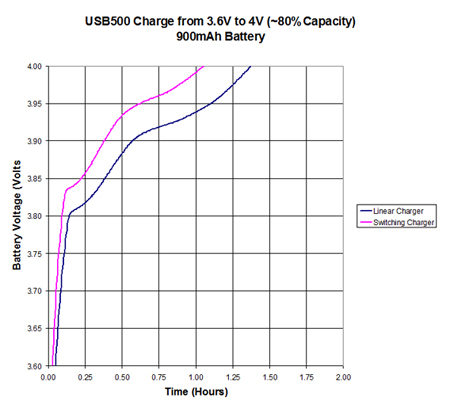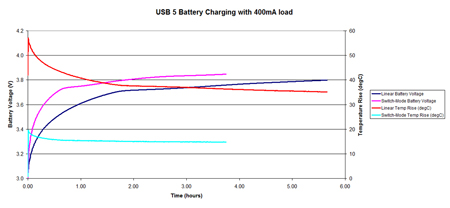This article discusses the selection process for deciding the battery charging topology in portable, consumer applications. The article analyzes system and battery conditions under which the benefits of specific solutions outweigh the benefits of others. The analysis focuses on technical issues, consumer usability and secondary effects, like cost, board size, complexity and flexibility. The large selection of battery packs and technologies combined with the wide variety of available battery charger ICs on the market and a wide range of system design approaches, makes the design very challenging -- especially if battery management is a new task for the engineer.
There are three basic battery charging types: linear, switch-mode and pulse chargers. Each of these types provides advantages and disadvantages, which make them ideal for specific applications. This article will focus on the first two, since pulse-charging is nowadays an unpopular method due to reliability concerns associated with continuous pulsing of the battery cell and other design constraints. While some of the pros and cons of the two popular charging types may seem very obvious (like low efficiency for linear charging and high electrical noise for switch-mode charging), most of them depend on system architecture, battery type/technology and other design considerations. For example, unlike 5 years ago, modern smart-phone designs utilize a variety of switch-mode, high-frequency power converters with optimized layouts that isolate noise from sensitive (RF) circuit. This makes the adoption of switch-mode charging more likely in modern wireless gadgets. On the other hand, new battery technologies with a higher regulation voltage are on the horizon; such batteries reduce the efficiency losses of linear battery chargers, making such charging solutions more appealing.
The selection of the battery charging implementation has become a major challenge in modern portable designs. Like with any other power management related function, in many cases it is the little details that determine the use of a specific IC. Choosing the battery charging architecture is a constant balancing act, since on one hand the higher the charge current the shorter the charging time, but on the other hand high charge current levels also prevent the solution to fit in ever-shrinking portable designs. Understanding the different battery charging alternative methods and their trade-offs will assist in selecting the ideal charger for a specific design. The basic selection process depends on five main factors: battery pack specification, system power architecture, system cost, industrial design, and marketing requirements.
Each battery pack provides several specifications such as battery capacity, battery technology, pack size, and recommended charging and discharging profiles. Most of these specifications determine the required charging current levels and charge regulation voltage that ensure long and safe battery life. The larger the battery capacity, the higher current levels are required to meet marketing's targets for charging times and avoid consumer frustration. While the majority of the batteries utilized today are Li-Ion and Li-Polymer, newer technologies are becoming popular with lower (3.6V) as well as higher (4.35V) regulation (float) voltages. These new technologies will require or be able to accommodate different charging methodologies. For example, since the power dissipation of a linear charger increases proportionally with the input (adapter) to battery differential, a LiFePO4 battery with a 3.6V float voltage will more likely require a switch-mode charger. On the other hand, a battery with a regulation voltage of 4.35V can easily be charged at the recommended 1C rate via a linear charger, unless the industrial design is extremely slim or the battery capacity is too large. Today most smart-phones are utilizing batteries with a capacity higher than 1100mAh and therefore have transitioned to switch-mode charging. The average battery capacities in the market keep getting higher to accommodate feature-rich portable devices, which consume ever-increasing power and thereby demand more frequent (and by definition also faster) battery charging. The figure below demonstrates charging time between linear and switch-mode charging from a current limited power source.

In addition to the battery selection, each new design utilizes a different power architecture. Many of the latest gadgets for example allow system operation without the presence of the battery, when the input power source is attached to the portable device. Such operation requires the system path to be separated from the battery path (CurrentPath™), thereby allowing instant-on system operation even with a deeply discharged or missing battery. Another component of the power architecture (ecosystem) is the wall adapter used for a specific application. Lower-cost, unregulated wall adapters may operate at higher voltages, thereby requiring a switch-mode charger for higher efficiency. On the other hand, even if the battery capacity is such that higher current is necessary for faster charging, if the adapter is limited to a lower current rating, a linear charger may be sufficient for meeting charging time targets. The system architecture can also have an effect on the battery charging algorithm, since a higher number of sophisticated systems implement real-time system power and battery charging methods to ensure optimum (i.e. higher-performance) operation, while maintaining system safety. Such system approaches are calling for power conversion and battery charging solutions that incorporate digital bus communication, thereby allowing dynamic parametric and functional alterations based on system, environmental and other conditions.
In addition to the battery selection, each new design utilizes a different power architecture. Many of the latest gadgets for example allow system operation without the presence of the battery, when the input power source is attached to the portable device. Such operation requires the system path to be separated from the battery path (CurrentPath™), thereby allowing instant-on system operation even with a deeply discharged or missing battery. Another component of the power architecture (ecosystem) is the wall adapter used for a specific application. Lower-cost, unregulated wall adapters may operate at higher voltages, thereby requiring a switch-mode charger for higher efficiency. On the other hand, even if the battery capacity is such that higher current is necessary for faster charging, if the adapter is limited to a lower current rating, a linear charger may be sufficient for meeting charging time targets. The system architecture can also have an effect on the battery charging algorithm, since a higher number of sophisticated systems implement real-time system power and battery charging methods to ensure optimum (i.e. higher-performance) operation, while maintaining system safety. Such system approaches are calling for power conversion and battery charging solutions that incorporate digital bus communication, thereby allowing dynamic parametric and functional alterations based on system, environmental and other conditions.

An increasingly critical factor in the selection of any power management IC solution, including battery chargers, is the device budget. The focus point of a cost analysis is the total Bill-of-Material cost for a specific function vs. solely the IC cost. While linear chargers used to have a significant cost advantage due to large adoption rates and their relatively low external component count and cost, as system designs become more complex, switch-mode charging ICs are quickly closing the gap. When analyzing the cost impact of various charging topologies, a closer looks needs to be taken for additional functionality required by the system design. Functions like input over-voltage and over-current protection, power source identification (is the input power source a USB port or a wall adapter with a USB connector?), or USB On-the-Go power support may require additional chips and/or external components. Hence, the monolithic integration of such functions can result in significant cost benefits, both in terms of component cost and expenses associated with inventory and assembly.
The "looks" and profile of cellular phones and other portable gadgets have been a major focus during the last two to three years, especially after the introduction of slick portable electronics such as the iPhone. In many cases the industrial design is the main driving force behind many of the other system- and battery-related decisions. Slim gadgets are pressured to keep temperature rise inside the case to a minimum, since there is not enough space for the heat to escape. The elimination of hot spots means a better consumer experience as well as higher system reliability. Keeping temperature levels low can be accomplished either by reducing the charging current level, which results in longer charging times and unhappy consumers, or by implementing a higher-efficiency charging method, such as switch-mode charging. The figure below demonstrates the difference in power dissipation generated with the linear and the switch-mode battery charging topologies when charging from a USB5 (500mA maximum) power source.

Portable electronic gadgets are marketed in appealing packages that contain specific technical characteristics and attributes. One popular (and obvious) marketing point is charging time. As mentioned in previous sections, high-efficiency battery charging topologies will always result in shorter charging time. Furthermore, the architecture of a switch-mode battery charging IC with TurboCharge™ technology is able to provide charge currents that are higher than the input currents, which again shortens the duration of the charge cycle. This current "multiplication" is extremely important with an increasing number of applications relying on charging from current limited USB ports and AC adapters, and with new-generation processors requiring a higher current level for system wake-up. Other technologies, such as the Low-battery Recovery Mode™, also exist on the marketplace, which enable a longer usable battery life. While in most designs once the battery reaches a typical cut-off threshold of around 3.4V the system is shut down, newer battery and power management implementations allow last-minute calls (911), even when the battery is more deeply discharged.
Defining and developing the battery charging subsystem of new portable designs is becoming an increasingly complex process. Budgetary, consumer, marketing and technology requirements are often at odds. Weighing the pros and cons of different charging topologies is key for optimizing the battery charging circuit of new product developments. It is important to look "under the hood" and understand the true benefits and costs of each topology and solution in relationship to the system's requirements. The goal is a sophisticated selection process that ensures that the end-products be reliable, provide a positive consumer experience, and keep total cost at acceptable levels. www.summitmicro.com